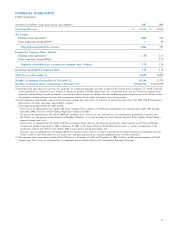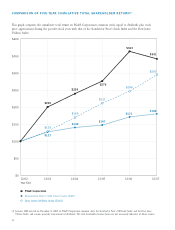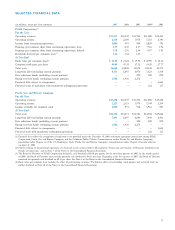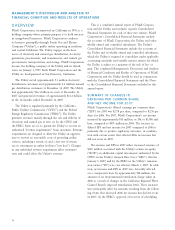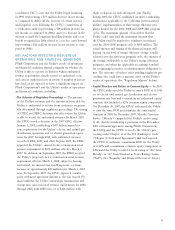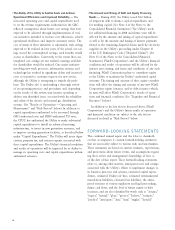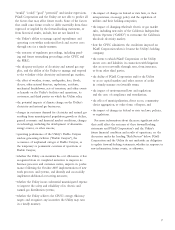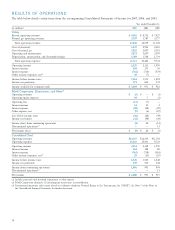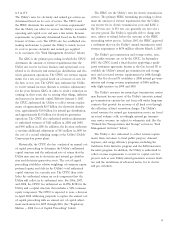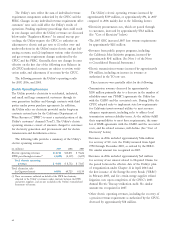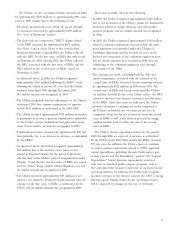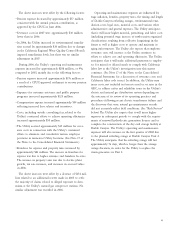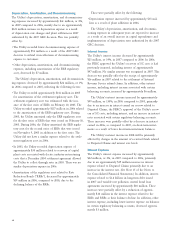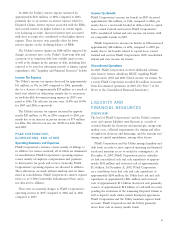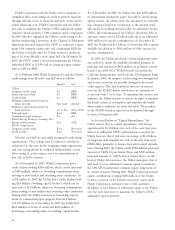PG&E 2007 Annual Report Download - page 41
Download and view the complete annual report
Please find page 41 of the 2007 PG&E annual report below. You can navigate through the pages in the report by either clicking on the pages listed below, or by using the keyword search tool below to find specific information within the annual report.39
UTILITY
The Utility’s rates for electricity and natural gas services are
determined based on its costs of service. The CPUC and
the FERC determine the amount of “revenue requirements”
that the Utility can collect to recover the Utility’s reasonable
operating and capital costs and earn a fair return. Revenue
requirements are primarily determined based on the Utility’s
forecast of future costs. The CPUC also has established rate-
making mechanisms to permit the Utility to timely recover
its costs to procure electricity and natural gas supplied
to its customers. (See “Risk Management Activities” below.)
The GRC is the primary proceeding in which the CPUC
determines the amount of revenue requirements that the
Utility can recover for basic business and operational costs
related to its electricity and natural gas distribution and elec-
tricity generation operations. The CPUC sets revenue require-
ments for a rate case period based on a forecast of costs for
the fi rst, or test, year. The CPUC may authorize the Utility
to receive annual increases (known as attrition adjustments)
for the years between GRCs in order to avoid a reduction in
earnings in those years due to, among other things, infl ation
and increases in invested capital. Effective January 1, 2007,
the CPUC authorized the Utility to collect revenue require-
ments of approximately $2.9 billion for electricity distribu-
tion, approximately $1.0 billion for natural gas distribution,
and approximately $1.0 billion for electricity generation
operations. The CPUC also authorized attrition adjustments
to authorized revenues of $125 million in 2008 and 2009,
and $90 million in 2010. In addition, the decision authorizes
a one-time additional adjustment of $35 million in 2009 for
the cost of a second refueling outage at the Utility’s Diablo
Canyon nuclear power plant.
Historically, the CPUC also has conducted an annual cost
of capital proceeding to determine the Utility’s authorized
capital structure and the authorized rate of return that the
Utility may earn on its electricity and natural gas distribu-
tion and electricity generation assets. The cost of capital
proceeding establishes relative weightings of common equity,
preferred equity, and debt in the Utility’s total authorized
capital structure for a specifi c year. The CPUC then estab-
lishes the authorized return on each component that the
Utility will collect in its authorized rates. For 2006, 2007,
and 2008, the CPUC has authorized an 11.35% ROE for the
Utility and a capital structure that includes a 52% common
equity component. The CPUC is expected to issue a decision
in April 2008 addressing proposals to replace the annual cost
of capital proceeding with an annual cost of capital adjust-
ment mechanism for 2009 through 2013. (See “Regulatory
Matters — 2008 Cost of Capital Proceeding” below.)
The FERC sets the Utility’s rates for electric transmission
services. The primary FERC ratemaking proceeding to deter-
mine the amount of revenue requirements that the Utility
can recover for its electric transmission costs and ROE is
the TO rate case. A TO rate case generally sets rates for a
one-year period. The Utility is typically able to charge new
rates, subject to refund, before the outcome of the FERC
ratemaking review process. In June 2007, the FERC approved
a settlement that sets the Utility’s annual transmission retail
revenue requirement at $674 million effective March 1, 2007.
The Utility’s gas transmission and storage service, rates,
and market structure are set by the CPUC. In September
2007, the CPUC issued a fi nal decision approving a multi-
party settlement agreement, known as the Gas Accord IV, to
establish the Utility’s natural gas transmission and storage
rates and associated revenue requirements for 2008 through
2010. The Gas Accord IV establishes a 2008 natural gas trans-
mission and storage revenue requirement of $446 million,
with slight increases in 2009 and 2010.
The Utility’s revenues for natural gas transmission services
may fl uctuate because most of the Utility’s intrastate natural
gas transmission capacity has not been sold under long-term
contracts that provide for recovery of all fi xed costs through
the collection of fi xed reservation charges. The Utility’s
actual revenues for natural gas transmission service are based
on actual volumes sold; accordingly, natural gas transmis-
sion service revenues are subject to volumetric risk. (See the
“Natural Gas Transportation and Storage” section in “Risk
Management Activities” below.)
The Utility is also authorized to collect revenue require-
ments from customers to fund public purpose, demand
response, and energy effi ciency programs, including the
California Solar Initiative program and the Self-Generation
Incentive program. In addition, the Utility is authorized to
collect revenue requirements to recover its capital costs for
projects such as new Utility-owned generation resource facili-
ties and the installation of advanced meters for its electric
and gas customers.




